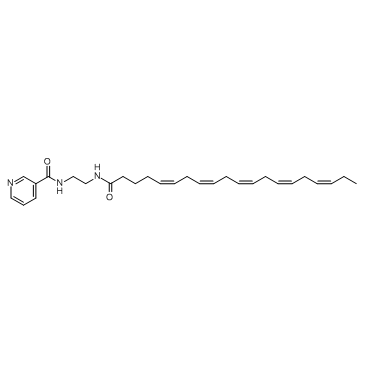1269181-69-2
| Name | Nicodicosapent |
|---|---|
| Synonyms |
72995E50VA
N-{2-[(5Z,8Z,11Z,14Z,17Z)-5,8,11,14,17-Icosapentaenoylamino]ethyl}nicotinamide 3-Pyridinecarboxamide, N-[2-[[(5Z,8Z,11Z,14Z,17Z)-1-oxo-5,8,11,14,17-eicosapentaen-1-yl]amino]ethyl]- nicodicosapent |
| Description | Nicodicosapent is a fatty acid niacin conjugate that is also an inhibitor of the sterol regulatory element binding protein (SREBP), a key regulator of cholesterol metabolism proteins such as PCSK9, HMG-CoA reductase, ATP citrate lyase, and NPC1L1. |
|---|---|
| Related Catalog | |
| In Vitro | Nicodicosapent decreases the production of mature SREBP-2 protein in HepG2 cells, but does not interact with the GPR109A receptor. Nicodicosapent shows a synergistic inhibition on secreted PCSK9 and has an IC50 value of 17 μM. Nicodicosapent significantly inhibits ApoB secretion in a dose-dependent manner with IC50 of 27 μM. Nicodicosapent results in a time-dependent hydrolysis in HepG2 cells[1]. |
| In Vivo | Nicodicosapent (100 mg/kg po) produces high plasma levels of nicotinuric acid in the plasma. ApoE*3-Leiden mice treated with Nicodicosapent show a significant reduction in PCSK9 levels, LDL particles including VLDL and LDL cholesterol, as well as plasma triglycerides[1]. |
| Animal Admin | Male Sprague-Dawley rats (n=4/treatment group) are administered with a single oral dose of either niacin (30 mg/kg) or Nicodicosapent (100 mg/kg). Compounds are formulated as an aqueous emulsion using Tween, Peceol, PEG400, and tocopherol. Nicodicosapent (170 mg) is formulated in 2.38 g of the oil mixture containing 40% Tween, 50% Peceol, 10% PEG400, and 0.2% tocopherol. The concentration of 5 in oil is 66 mg/g of oil. For oral dosing, this oil formulation is then diluted with 14.25 mL of water to form a 10 mg/mL drug emulsion and dosed as an oral gavage. Collection time points are 5, 15, and 30 min 1, 2, 4, 6, and 8 h postdose. Blood samples are collected via saphenous vein and placed in tubes containing paraoxon (10 μL of a 200 μM solution in DMSO) and stored on an ice block until centrifuged at 8000 rpm for 6 min at 2-8°C. The resulting plasma is kept frozen at −80°C until analysis. Nicodicosapent, nicotinic acid, and nicotinuric acid standard curves are generated to allow for quantitative analysis of plasma samples. Standard curves are generated by adding 10 μL of a given compound in methanol (50 μg/mL) to 50 μL of blank plasma in a 96-well microplate, resulting in the following final concentration range: 8333, 2083, 521, 130.2, 32.5, 8.1, 2.0, and 0.5 ng/mL. Then 300 μL of acetonitrile containing 100 ng/mL of an internal standard is added to each sample. The 96-well microplate is vortexed for 30 s and is then centrifuged for 45 min at 2300 g. Then 100 μL of supernatant is transferred from each sample to an empty 96-well microplate for analysis by LC/MS/MS. The instrument used is an Agilent liquid chromatograph equipped with a binary pump (1200 series), an autosampler (1200 series), and a degasser (1200 series). Mass spectrometric analysis is performed using an Agilent 6410 triple quadrupole with an ESI interface. The data acquisition and quantitation is done with Agilent Masshunter software. The column used is a Phenomenex Gemini C6 Phenyl 110A 50 mm×4.6 mm, 1.8 μm. The following mobile phase gradient is used (water = solvent A; methanol = solvent B): 0.01 min=45%A/55%B; 0.5 min=45%A/55%B; 1 min=5%A/95%B; 3.5 min=5%A/95%B; 3.51 min=45%A/55%B; 4 min=45%A/55%B. |
| References |
| Density | 1.0±0.1 g/cm3 |
|---|---|
| Boiling Point | 677.5±55.0 °C at 760 mmHg |
| Molecular Formula | C28H39N3O2 |
| Molecular Weight | 449.628 |
| Flash Point | 363.5±31.5 °C |
| Exact Mass | 449.304230 |
| LogP | 5.65 |
| Vapour Pressure | 0.0±2.1 mmHg at 25°C |
| Index of Refraction | 1.540 |
| Storage condition | 2-8℃ |
